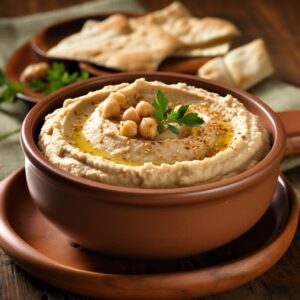
Introduction:
Hummus, the creamy and flavorful Middle Eastern dip, has transcended borders to become a beloved staple in kitchens worldwide. With its rich history and versatile nature, hummus holds a special place in the hearts of food enthusiasts everywhere. Join us as we embark on a culinary journey to explore the authentic flavors and simple pleasures of homemade hummus.
Ingredients:
- 1 can (15 ounces) of chickpeas (garbanzo beans), drained and rinsed
- 1/4 cup fresh lemon juice (about 1 large lemon)
- 1/4 cup tahini (sesame paste)
- 1 small garlic clove, minced
- 2 tablespoons extra virgin olive oil, plus more for serving
- 1/2 teaspoon ground cumin
- Salt to taste
- 2 to 3 tablespoons water
- Optional toppings: paprika, chopped fresh parsley, extra olive oil, pine nuts
Instructions:
- In a food processor, combine the drained chickpeas, lemon juice, tahini, minced garlic, olive oil, cumin, and a pinch of salt.
- Process the mixture until smooth and creamy, scraping down the sides of the bowl as needed.
- Gradually add water, one tablespoon at a time, until the hummus reaches your desired consistency. Continue processing until well combined.
- Taste the hummus and adjust the seasoning with additional salt or lemon juice, if needed, to suit your preference.
- Transfer the hummus to a serving dish and drizzle with extra virgin olive oil. If desired, sprinkle with paprika, chopped fresh parsley, or toasted pine nuts for added flavor and visual appeal.
- Serve the hummus immediately with warm pita bread, fresh vegetables, or as a spread for sandwiches and wraps.
Tips for Success:
- For extra smooth and creamy hummus, remove the skins from the chickpeas before processing. Simply pinch the chickpeas between your fingers to loosen the skins, then discard.

- If you prefer a more intense garlic flavor, roast the garlic cloves in a dry skillet over medium heat until fragrant and golden brown before adding them to the hummus mixture.
- Experiment with additional flavorings and variations, such as roasted red peppers, sun-dried tomatoes, or fresh herbs, to customize your hummus according to your taste preferences.
- Store leftover hummus in an airtight container in the refrigerator for up to one week. Before serving, let the hummus come to room temperature and give it a stir to recombine any separated oils.
Conclusion: Whether enjoyed as a snack, appetizer, or accompaniment to a main meal, homemade hummus offers a delightful burst of flavor and nourishment with every bite. With its simple preparation and endless versatility, hummus is sure to become a cherished favorite in your culinary repertoire. Gather your loved ones, whip up a batch of authentic Middle Eastern hummus, and savor the joy of sharing good food and good company together. Shukran (thank you) for joining us on this delicious journey!

